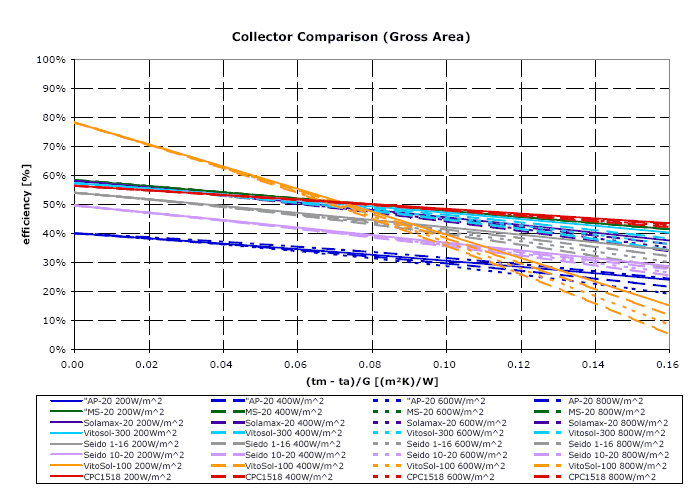

What does all this mean?
- Gross area:
- Gross area collector efficiency represents the percentage of sunlight converted to heat, based upon the total area of the collector. This represents the true power density of the collector.
- Aperture area:
- Aperture area collector efficiency represents the percentage of sunlight converted to heat, based upon the aperture area.
- Absorber area:
- Many thermal collector distributors use absorber area to describe efficiency. The absorber area specified for CPCs needs a more detailed explanation. Due to the fact that the CPC surface behind each vacuum tube directs solar radiation onto the vacuum tube absorber surface the collector efficiency could become greater than 100% if the physical absorber plate area within each vacuum tube is taken as absorber area reference. However, it is general practice in the solar community to use the area of the entire concentrating (CPC) surface as reference. This makes the maximum possible efficiency of the CPC 100% if all components are ideal ( i.e. all radiation is concentrated onto the absorber with no losses). Therefore, if we were to compare absorber area of the CPC we would actually be comparing CPC aperture area with smaller absorber areas of other non CPC types.
- G:
- Represents the solar irradiation incident upon the collector.
- Many factors affect solar irradiation such as season, clouds, time of day, orientation of the collector, and potential obstructions of the collector (building, tree, hill).
- tm:
- tm represents the mean temperature of the fluid that is traveling through the collector.
- tm=(tinlet+toutlet)/2
- ta:
- ta represents the ambient temperature that the collector is placed in (i.e. how hot or cold it is outside).
- (tm-ta)/G:
- Collector efficiency drops as solar irradiation decreases, and the temperature difference of the collector and the ambient increases.
- Example values to consider:
- Domestic hot water:
- tm=48C
- ta=0C
- G=450W/m2
- (tm-ta)/G=.11
- Radiant floor heating:
- tm=30C
- ta=0C
- G=450W/m2
- (tm-ta)/G=.07
- Air handler heating:
- tm=65C
- ta=0C
- G=450W/m2
- (tm-ta)/G=.14
- Absorption chiller:
- tm=87.5C
- ta=30C
- G=700W/m2
- (tm-ta)/G=.08
- Please note: tm, ta, and G will vary continuousy throughout the course of the day, year, etc. In order to decide which collector is best for your application, a time weighted average of (tm-ta)/G should be determined.
- Collectors compared above:
- Mazdon MS-20 - TMO 500, Thermomax, http://www.thermomax.com/
- Solamax-20 - TDS 300, Thermomax, http://www.thermomax.com/
- Apricus AP-20, Apricus, http://www.apricus.com/
- VitoSol 100 S2.5, Viessmann, http://www.viessmann-us.com/
- Vitosol 300, Viessmann, http://www.viessmann-us.com/
- Seido 1-16, Sun Spot Solar/Beijing Sunda Solar Energy Technology, http://www.sssolar.com/
- Seido 10-20, Sun Spot Solar/Beijing Sunda Solar Energy Technology, http://www.sssolar.com/
- Performance data for solar collectors obtained from SPF Solartechnik and Universität Stuttgart Institut für Thermodynamik
und Wärmetechnik
What should I look for in a solar collector?
- The higher the gross collector efficiency, the less space you will need to install thermal collectors and still satisfy your thermal loads.
- Not presented here is the effect of incident angle modifiers on the efficiency of the collector. Additional consideration of these incident angle characteristics should be taken into account when determining efficiency of a collector in your application/climate.
- Low cost/area/efficiency in the operating range of your application/climate.
|
|



